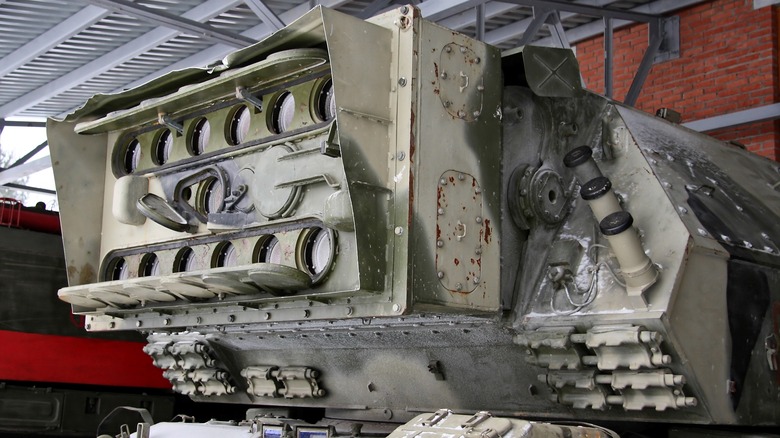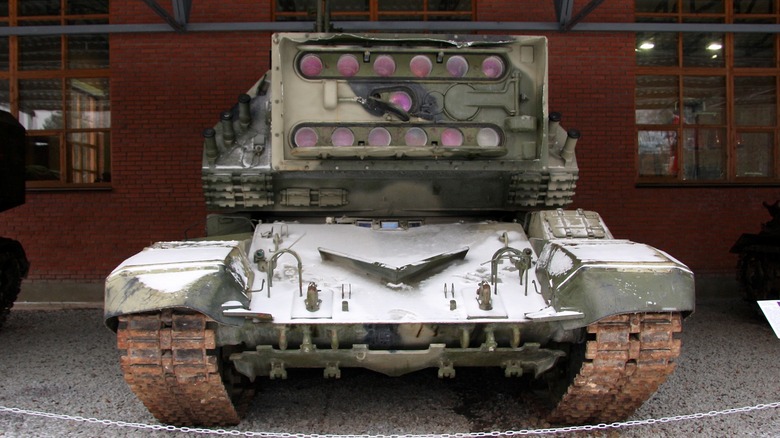When you hear “laser tanks,” your mind may conjure scenes from “Star Wars” or “Battlestar Galactica” rather than anything real. Sometimes truth can be stranger than fiction. Laser tanks aren’t just a sci-fi concept — they’re very much real, and prototypes have existed since the Cold War era.
From the 1970s until the collapse of the Soviet Union, a clandestine project worked at creating a vehicle equipped with a directed energy weapon (DEW) that could be used against the West, should the Cold War ever turn hot. This project was so covert that enemy intelligence only became aware of it through information provided by defectors. Several prototypes came from the project, but the last surviving example is the 1K17 Szhatie (Russian for “Compression”.)
The system’s design is surprisingly simple. The Soviet Union took the chassis of the 2S19 Msta-S self-propelled howitzer and eliminated the turret and mounted a laser emitter on top. The concept is to use the high-intensity laser beam produced by the emitter to disrupt the guidance systems of incoming missiles, effectively turning the 1K17 into an anti-missile platform. Additionally, there was the hope that the laser could blind or even destroy the enemy’s sensitive cameras, sensors, and scopes.
[Featured image by Vitaly V. Kuzmin via Wikimedia Commons | Cropped and scaled | CC BY-SA 4.0]
The Soviet’s Decade-long Quest for a Laser-armed Tank
The 1K17 was one of the many prototypes the Soviet Union built in its quest for a “Self-propelled Laser Complex” (SLK). The concept was initially proposed in the 1970s and early 1980s with the development of the 1K11 Stilet. The Luch Central Design Bureau, under the leadership of Gen. Dmitry Ustinov, engineered two prototypes to deliver around 1982. The 1K11 complex had a laser emitter atop a tracked chassis.
After the Stilet was the “Sangvin” (Sanguine). This prototype utilized the chassis of the ZSU-23-4 Shilka self-propelled anti-air gun. The guns were removed and replaced with a single laser emitter to disable the sensors and optics of combat aircraft. While there is limited test data available today, numerous sources suggest that at ranges of five to six miles, the Sanguine could leave a helicopter inoperable.
The most advanced SLK arrived in 1989, in the form of the 1K17 Szhatie, but so did the end of the Soviet Union. However, the Russian military powered ahead, Assembled in December 1990 and trialed until 1992, the Szhatie demonstrated promising results during testing. However, despite the success of the trials, the 1K17 never entered full-scale production or service.
[Featured image by Vitaly V. Kuzmin via Wikimedia Commons | Cropped and scaled | CC BY-SA 4.0]
The Fascinating Design of the 1K17

While information about earlier designs like the Stilet and the Sangvin is limited, the 1K17 prototype not only still exists today, but it has been photographed in great detail. As mentioned earlier, the 1K17 was constructed on the chassis of the 2S19 Msta-S. The original gun was removed, and the turret underwent significant modifications to accommodate the solid-state laser equipment as well as the beefy generator required to pump power to the lasers.
The emitter has 13 lenses: one centerpiece while the other 12 splits into two surrounding rows. The lasers are essentially rubies powered by Xenon gas by way of lamps. Additionally, the 1K17 can emit short laser “bursts” using aluminum garnet devices. While specific details about the system’s effective range are unclear, it is expected to match or even exceed the five to six-mile range of the earlier systems.
Incapable of much direct action, the 1K17 featured an NSVT heavy machine gun mounted on the commander’s cupola and six smoke launchers for self-defense. In combat, however, this specialized vehicle is pretty much guaranteed to have flanking escorts to protect it from harm.
[Featured image by Vitaly V. Kuzmin via Wikimedia Commons | Cropped and scaled | CC BY-SA 4.0]
A Controversial Weapon That Never Was

Had the 1K17 Szhatie been deployed on the battlefield, it could have profoundly impacted modern warfare. As a defensive weapon, its laser was highly effective at disabling enemy vehicles, weapons, and visual equipment. However, it could also be repurposed as an assault weapon against infantry.
The laser emitted by the 1K17, while unknown in intensity, had the potential to instantly blind when directed at the naked eye. considering it’s potent enough to disable electronics at miles away. Laser weapons could have become prolific on battlefields, but in 1995, the Geneva Convention’s Blinding Laser Weaponry Protocol ended their potential reign of terror before it could begin.
Despite the 1K17 Szhatie project only making it to one prototype, it remains an intriguing yet lesser-known chapter in Soviet military history. You can see a prototype of the 1K17 today at the Military Technical Museum near Moscow. Regrettably, the Stilet and Sangvin prototypes were likely destroyed following the collapse of the Soviet Union, with the last documented photograph of the Sangvin taken in a St. Petersburg junkyard.
[Featured image by Vitaly V. Kuzmin via Wikimedia Commons | Cropped and scaled | CC BY-SA 4.0]
